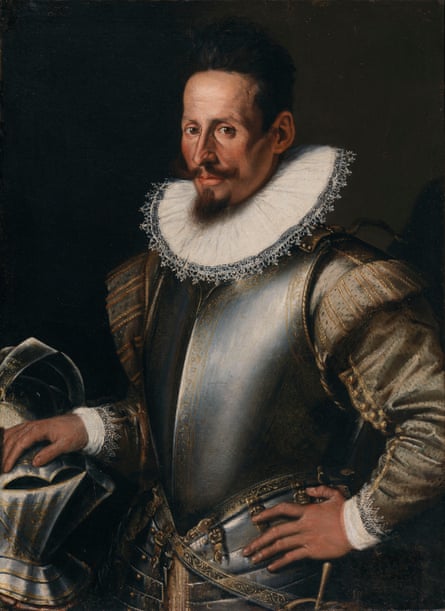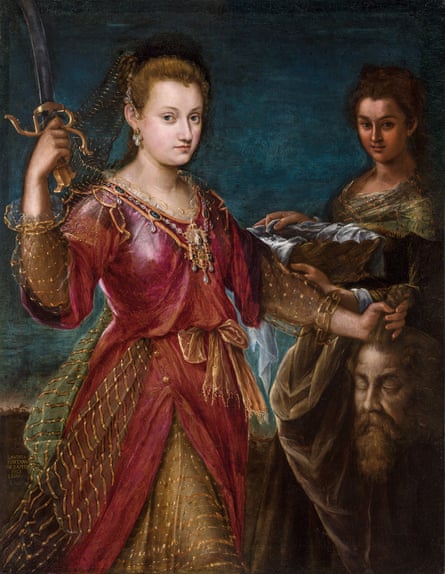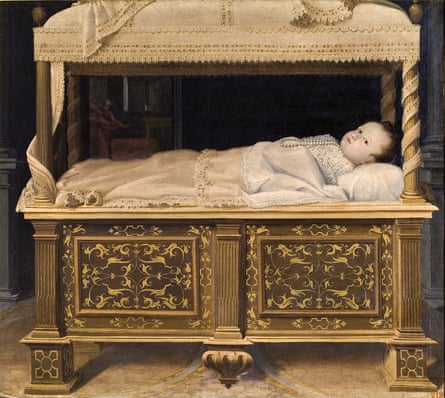Arguably nothing in art embodies the male gaze more than the Renaissance nude, that genre of licentious painting in which the likes of Titian and Bronzino excelled. But an exhibition opening at the National Gallery of Ireland in Dublin next month proves that a Renaissance woman took on the boys in this very genre – and did it just as outrageously.
Lavinia Fontana’s nudes were so unprecedented that experts argue about how she even got access to models. For a woman to be an artist in the 1500s was rare, for her to work with naked models unheard of. But, as Aoife Brady, curator of the Dublin exhibition, points out, she did have unique access to one subject – herself. The naked goddess Minerva looks out from Fontana’s 1613 work Minerva Dressing as if she were regarding herself in the mirror: it is the same look the artist gives the mirror in her clothed self-portraits.
Another painting, Mars and Venus, depicts the love affair between the goddess of desire and the god of war in a cheekily intimate way. As they sit on the edge of a bed curtained with dark-wine silk hangings, Mars puts a hand on Venus’ naked bum. She turns to look at us in a challenging way, complicit in the lewd promise of what is to come. Fontana painted this in about 1595. No other naked Renaissance paintings by women are known to have existed before her. Then again she set many other precedents, from supporting her family by selling her works to being appointed the pope’s portraitist.

She was born in Bologna in 1552 and trained with her father, the artist Prospero Fontana: having an artist parent was almost the only way a girl could learn art in Europe where the traditional workshop system was open solely to male apprentices. When she was a teenager the sculptor Giambologna created his Fountain of Neptune that still flows in the centre of the city, featuring four female figures who spurt water like milk from their naked breasts. These lactating Nereids celebrate the only role women were supposed to aspire to in the Renaissance – being a wife and mother. Fontana give birth to 11 children, most of whom died young. Yet Bologna was one city where women were able to aspire to more.
“It’s hard to say that Bologna was a paradise for women but it is very striking how different the opportunities were between it and, say, Florence”, says Caroline Campbell, recently appointed as the director of the National Gallery of Ireland – the first woman to have the job. Born in Belfast, she was in charge of Renaissance Italian art at London’s National Gallery before this move. “It was the perfect Petri dish for Lavinia’s career,” adds Brady. “It is home to the world’s oldest university, which awarded doctorates to female students from as early as the 13th century. It wasn’t ruled by a court and therefore there was a certain freedom that people experienced in Bologna unlike the neighbouring states, that Fontana certainly took advantage of. It was definitely a city that afforded female artists more opportunities than others.”

Fontana wasn’t the first woman to become a professional artist here: in early 16th-century Bologna the sculptor Properzia de’ Rossi fought her way into a career, quite literally according to court records that show she was accused of attacking a male rival by chucking paint at him and scratching his eyes. Fontana took a more traditional route: she networked with Bologna’s elite families and became their favourite portraitist. Her friendship with upper-class women is very evident in her more than three-metre wide history painting The Visit of the Queen of Sheba to King Solomon, which Campbell calls her “masterpiece”. As the Queen of Sheba hails Solomon she is accompanied by an elegant female retinue, all in Renaissance clothes including ruff collars and magnificently vertical hairstyles, and all strongly individualised: some look straight at us, others pose haughtily or casually. They are all quite obviously portraits. Just as male painters from Veronese to Zoffany filled crowd scenes with male friends or notables, so Fontana has included her female friends in this spectacular scene.
The Visit of the Queen of Sheba to King Solomon was the seed of Campbell’s and Brady’s exhibition. Walking through the National Gallery of Ireland’s galleries before the pandemic, I was captivated by this painting as well as a fine portrait of Prince Alessandro Farnese by the Cremonese painter Sofonisba Anguissola. While other museums are rushing to improve their representation of female artists, the Renaissance rooms in Dublin have always been ahead. The Anguissola was part of the gallery’s founding collection of 112 paintings when it opened in 1864, although it was wrongly attributed to a man; Fontana’s Sheba was the first work by a female artist knowingly acquired by the gallery in 1872 and has been part of Dublin’s culture ever since.
“Solomon and the Queen of Sheba is a very well-known painting in Dublin”, says Campbell. “Even if people don’t remember the artist they know the painting – they say: ‘Oh yes it’s that picture, I saw that as a child.’ So we felt it was very important for people to have a greater sense of Lavinia Fontana herself as an artist”.

The exhibition is an eye-opening feast of portraits, mythology, drawings and Madonnas that showcase Fontana as a true Renaissance woman at the artistic and intellectual cutting edge of her time. Her portraits alone add up to a brilliant artistic achievement. She has an acute eye for human uniqueness that makes them live on on canvas after all these years. An Unknown Noblewoman Seated in a Chair regards us coolly and knowingly: we get a strong sense of her consciousness within that tight ruff collar. Another woman catches your eye, contemplating you from pensive shadows. But Fontana also paints men with the same intimacy, often showing them at their desks pondering learned volumes: one is an astrologer studying a big book of occult lore.
She puts herself among these Renaissance men, displaying her own intellect and achievements. In one self-portrait, Fontana sits at the virginals, showing off the kind of musical skills that would still be a typical “accomplishment” for elite women in the novels of Jane Austen. In her Self-Portrait in a Studio she does not stress politeness but instead projects herself as a professional artist sketching among her collection of statuettes.
after newsletter promotion
She sees children with the same sympathy as adults, from a baby in a tomb-like crib to a father and son whose large and small presences are humorously juxtaposed. In her most charismatic painting of all – the one masterpiece the Dublin gallery couldn’t borrow for their show, although they will exhibit a drawing for it – Fontana portrays Antonietta Gonzalez, a young child with a hairy face. It’s a wondrous document of her age, when human beings who seemed to defy nature were exhibited at fairs or in the case of Antonietta and her hirsute family, toured European courts.

Being a female artist five centuries ago was a rarity, but Fontana carried it off with such confidence and coolness she made it seem natural to her contemporaries. Indeed, Campbell doesn’t think we should focus exclusively on her sex any more than they did: “We don’t want to be seeing Lavinia Fontana as a prodigy artist: we want to be looking at her as a painter on her own terms. Her gender is obviously very significant but primarily she is an extraordinary, talented painter, and draughtswoman as well.”
Brady agrees: “We’re trying not to be too hung up on the fact that they were created by a woman and to come back to the artworks themselves and celebrate them for what they are.”
Fontana is simply a fantastic observer of the people of her world, naked and clothed, from astrologers and artists to the dwarf who attends the women in The Visit of the Queen of Sheba. He is boldly himself as he looks up at the company of women, his hand in his sash behind him in a gesture of self-possession and cocky pride. A Renaissance man painted by a Renaissance woman.
"artist" - Google News
April 24, 2023 at 11:20PM
https://ift.tt/vXdjM8F
Bottom-fondling audacity: how did Lavinia Fontana get away with it? - The Guardian
"artist" - Google News
https://ift.tt/QN42D9i
Bagikan Berita Ini














0 Response to "Bottom-fondling audacity: how did Lavinia Fontana get away with it? - The Guardian"
Post a Comment